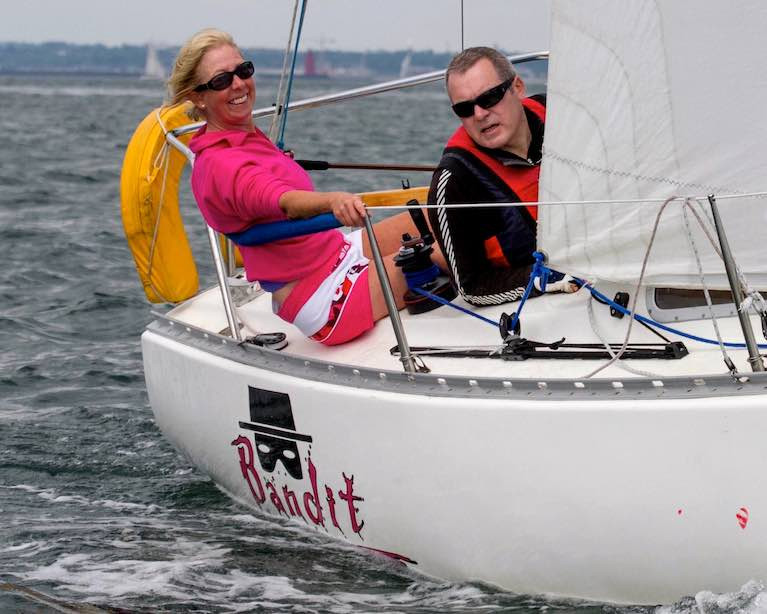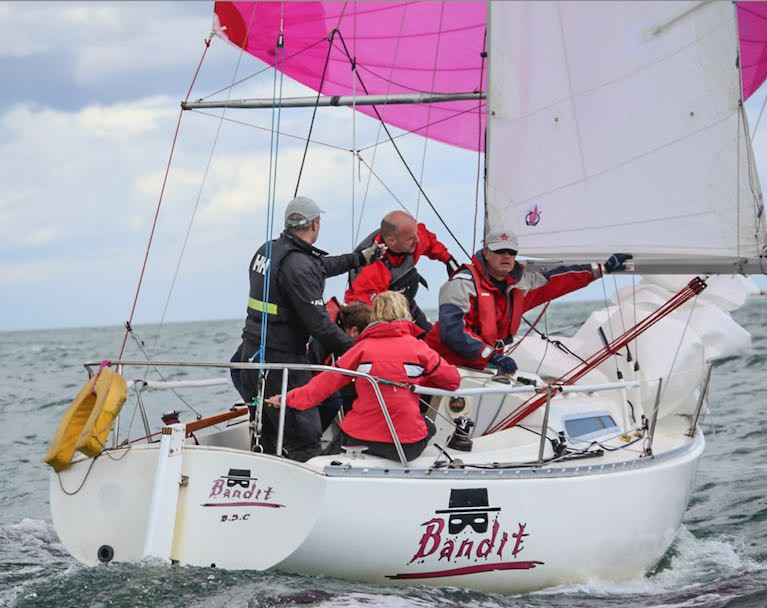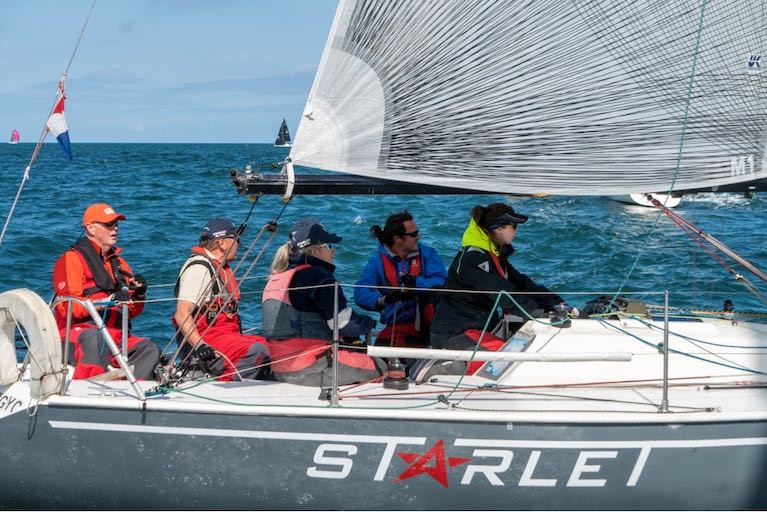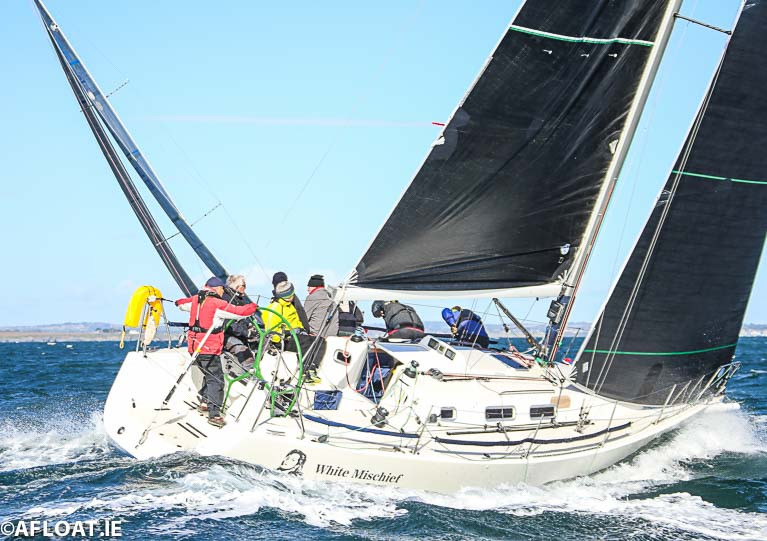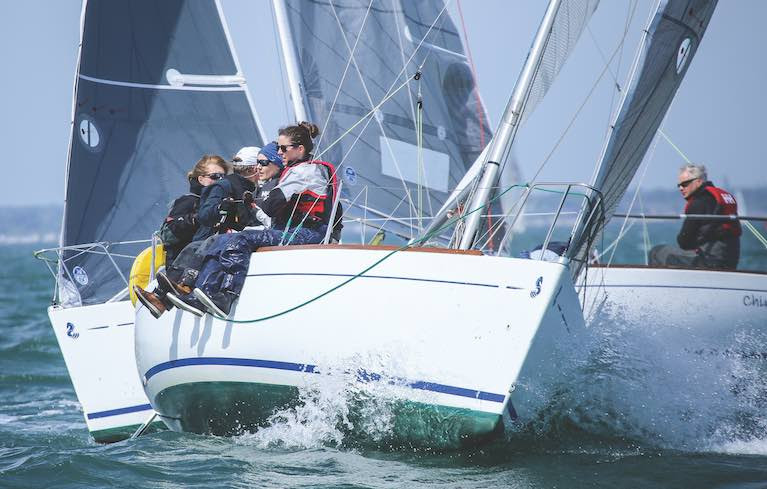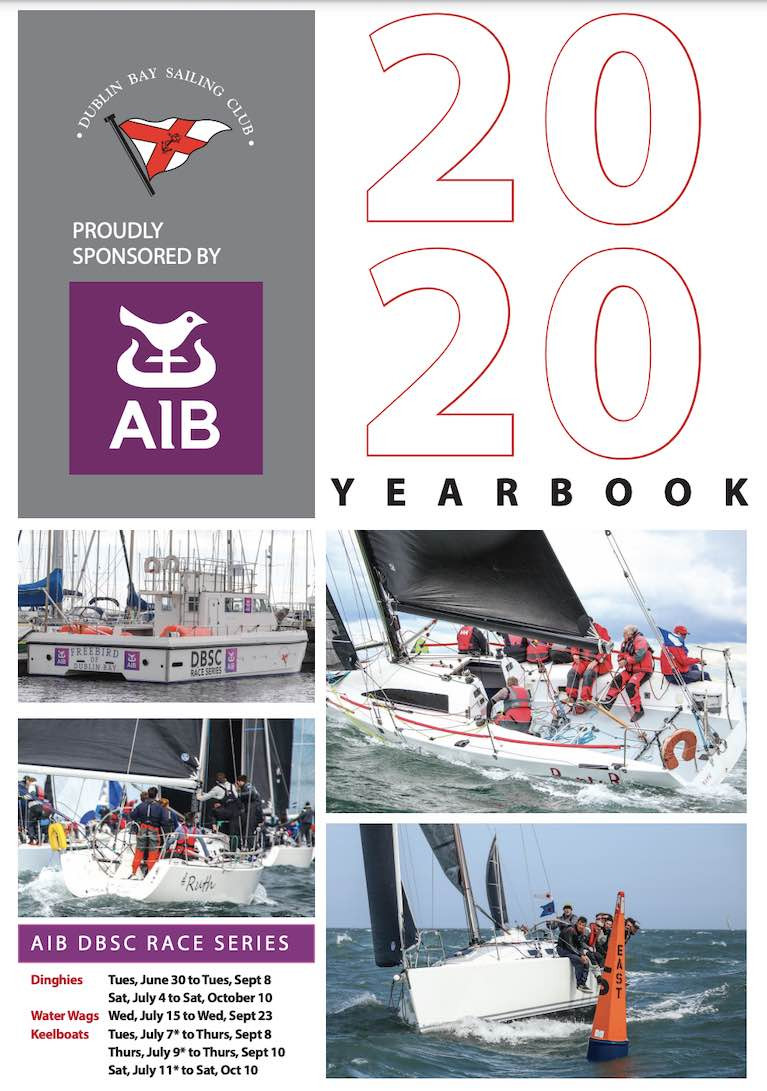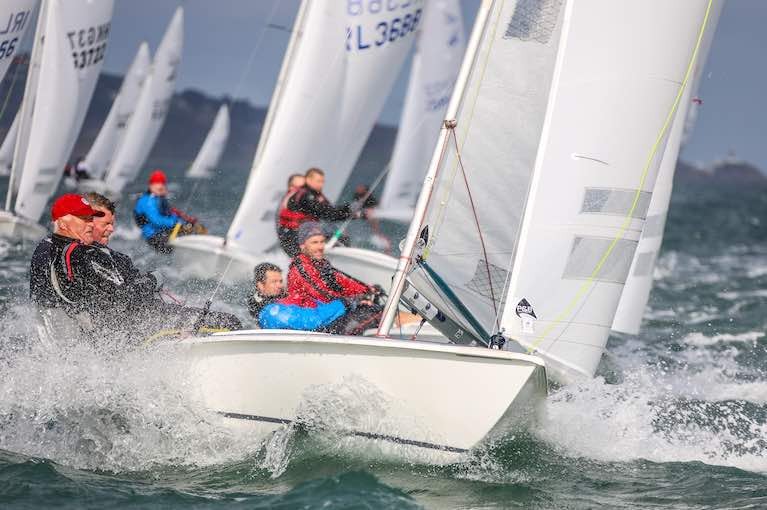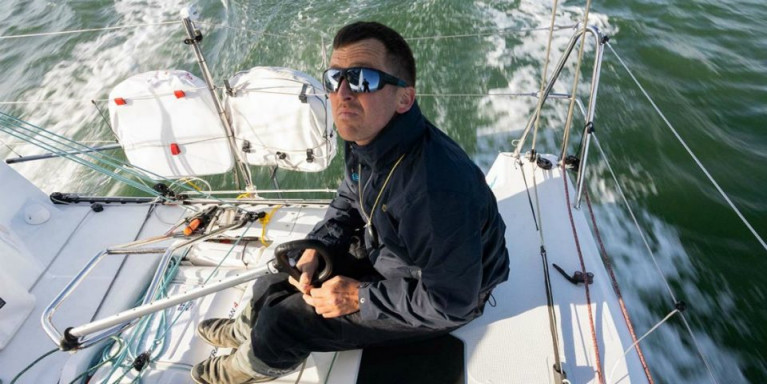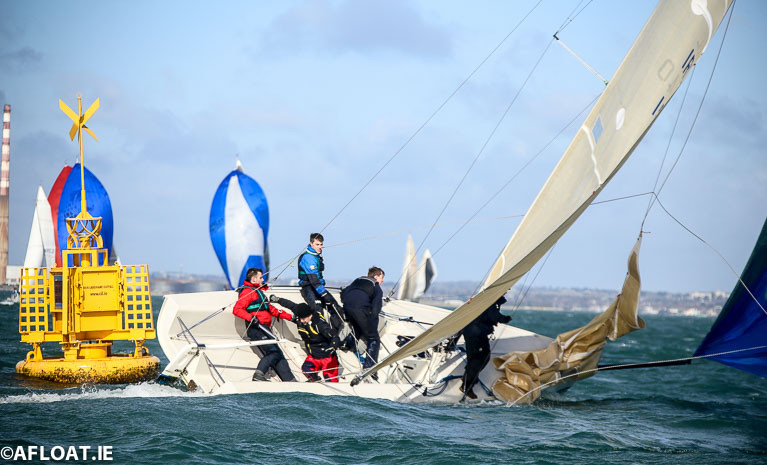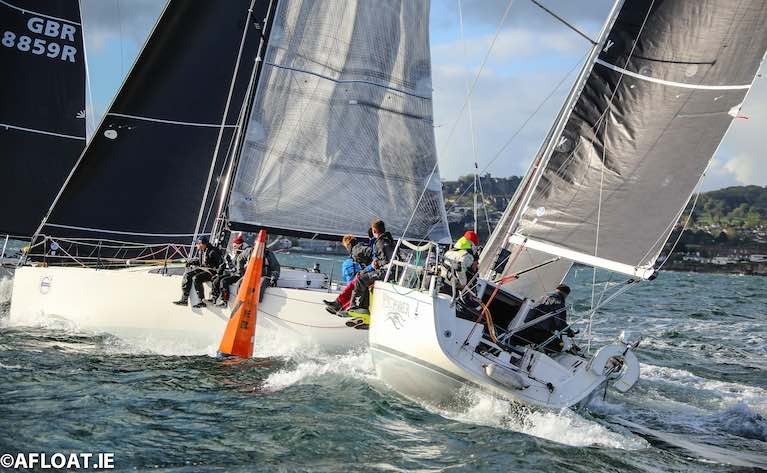Displaying items by tag: Dublin Bay Sailing Club
New Dublin Bay Commodore Ann Kirwan Brings Many Talents to DBSC
This week, Ann Kirwan of the National Yacht Club became the 25th Commodore of Dublin Bay Sailing Club at the club's 136th Annual General Meeting, in succession to Jonathan Nicholson of the Royal St George YC. This harmonious change of the watch comes at the conclusion of a truncated season in which, despite the adverse effects of the pandemic, DBSC managed to put through a very complete yet still fully COVID-compliant AIB-sponsored racing programme.
In order to understand how this was possible, we need to look at the origins of the club, and how it comes to be in the unique position it fills today. For if there's another sailing body in the world which can be reasonably ranked with Dublin Bay Sailing Club, then we'd be interested to hear about it for purposes of comparison.
The extraordinary Dun Laoghaire organisation is at the core of a seemingly unique sailing structure which is based on the competitive waterborne needs of a notably affluent, cohesive and compact maritime population in South Dublin, a population which gets to the sea via the one harbour of Dun Laoghaire through four different waterfront clubs in combination with the largest marina in Ireland.
 A possibly unique setup. Virtually all of South Dublin's recreational boating activity on Dublin Bay has to be funnelled through the entrance to Dun Laoghaire Harbour, and thus the development of the overall co-ordinating body of Dublin Bay Sailing Club became inevitable.
A possibly unique setup. Virtually all of South Dublin's recreational boating activity on Dublin Bay has to be funnelled through the entrance to Dun Laoghaire Harbour, and thus the development of the overall co-ordinating body of Dublin Bay Sailing Club became inevitable.
 The only tangible evidence of the existence of Dublin Bay SC is in its Committee Boats and its extraordinary collection of historic annual prizes. Photo: Afloat.ie/David O'Brien
The only tangible evidence of the existence of Dublin Bay SC is in its Committee Boats and its extraordinary collection of historic annual prizes. Photo: Afloat.ie/David O'Brien
Yet the over-arching DBSC itself has neither a clubhouse nor even the most modest jetty, although it does have three Committee Boats. But the three more stately clubhouses were already in being when Dublin Bay SC was founded in 1884. Yet although those established clubs had substantial fleets – with the Royal St George YC supposedly rivalled only by the Royal Yacht Squadron in the combined tonnage of its affiliated yachts – the number of races which actually took place was surprisingly small.
Admittedly the racing programme was becoming more busy with the "homeless" Royal Alfred YC - founded 1870 in Dublin Bay - leading the way in codifying the rules in order to establish the Yacht Racing Association and put a fresh emphasis on amateur crewing. But the notion of a season-long regular weekly programme including evening events was still barely in its infancy.
 One hundred and thirty-six years down the line, and the DBSC racing goes on – in 2020, Patrick Burke's First 40 Prima Forte was the winner of the Dun Laoghaire Harbour Trophy for the best new DBSC yacht. Photo: Afloat.ie/David O'Brien
One hundred and thirty-six years down the line, and the DBSC racing goes on – in 2020, Patrick Burke's First 40 Prima Forte was the winner of the Dun Laoghaire Harbour Trophy for the best new DBSC yacht. Photo: Afloat.ie/David O'Brien
Indeed, it used to be thought quite an achievement to "cram" three races into the mad social whirl which was Cowes Week, something which had been underlined back in 1851 when the race round the Isle of Wight for what was to become the America's Cup was included almost as an after-thought on the Friday, when many liverish aristocratic Cowes Week participants were already thinking of heading home towards their stately piles.
But in 1884, Dublin Bay Sailing Club – nowadays the very heart of the Establishment – was set up to be The Disruptor. At variance with the large yachts which needed numerous crew, DBSC was avowedly in favour of small inexpensive craft sailed by their owners with a crew of amateur friends. Its purpose was to fit in as many races as could reasonably be accommodated during the course of the season, with any heavy social side being a very secondary consideration, if it figured at all.
The new club captured the mood of the moment, which was already being expressed in a lower key by the 1887-established Water Wag Class. But where the Wags were a one-boat-type setup, the new DBSC had a broader outlook. It went well with the new spirit of the last two decades of the 19th century, and was to be perfectly in tune with the desire for sailing innovation and boat-improvement which set the tone of the Golden Age of Yachting from 1890 to 1914.
 A new One-Design Class from the early days – the Dublin Bay 25s racing in 1901. Photo courtesy DBSC
A new One-Design Class from the early days – the Dublin Bay 25s racing in 1901. Photo courtesy DBSC
 21st Century One Design – the Beneteau First 21 is the most recent class to be adopted as a Dublin Bay One Design. Photo: Afloat.ie/David O'Brien
21st Century One Design – the Beneteau First 21 is the most recent class to be adopted as a Dublin Bay One Design. Photo: Afloat.ie/David O'Brien
Thus within a decade of its establishment, even though it was set up seven years after the establishment of the world-pioneering Water Wag class, DBSC had become the "go to" organisation – and was often the originator - for any group of fellow-minded enthusiasts who had a new restricted or One-Design class in mind. Thus by the turn of the Century it was DBSC which was mustering Dublin Bay-based racing fleets of such numbers that it had become the de facto central body for organizing regular weekly racing in the bay, regardless of which shore-based clubs claimed the loyalties of the participants.
All this may have been taking place more than a century ago. But the special spirit of the club has endured. It has developed and become reinforced ever since to such an extent that to be part of the large group of volunteers which keeps DBSC running smoothly – a group who sail all sorts of boats and are drawn from all four waterfront clubs – is to share an active vocation.
In this, the new Commodore sees herself as being representative of a large like-minded grouping of equals. Yet the fact is that being Commodore of Dublin Bay Sailing Club means that you're in one of Irish sailing's most significant individual roles. And while DBSC is run in such a way that the changing of personnel in the key administrative positions is phased to keep the overall machinery functioning smoothly, being Commodore is where the buck stops.
 The numerically largest One-Design keelboat class currently racing on the bay is the Flying Fifteen, with former NYC Commodore Ronan Beirne seen here crewing for David Mulvin. Photo: Afloat.ie/David O'Brien
The numerically largest One-Design keelboat class currently racing on the bay is the Flying Fifteen, with former NYC Commodore Ronan Beirne seen here crewing for David Mulvin. Photo: Afloat.ie/David O'Brien
Time was when the Commodore was more of a figurehead role, and thus it is only relatively recently in DBSC history that the position has been rationed to just two years in office. But this means that while the longer-serving role of Honorary Secretary (currently filled in succession to the wonderfully long-serving Donal O'Sullivan by Chris Moore, himself a former DBSC Commodore) is the conduit through which club communications, directives and notices flow, the Commodore can now have a much more hands-on role.
And when you get an active sailing enthusiast and ideas-person like Ann Kirwan in the top position, their sailing background and their approach to the problems which sailing – like all sports – faces in these pandemic times will directly affect how life afloat develops for Dun Laoghaire's large sailing population in 2021 and 2022.
In Commodore Kirwan, the racing sailors of Dun Laoghaire have a leader who shares their enthusiasm for the best of sport afloat with an energetic capacity for working effectively with other volunteers for the good of their shared interest, and at the same time having professional experience of functioning in a large working organization, while bringing an inspirational zest to everything she does.
 Ann Kirwan in action in the crewing department, quite prepared to believe that Dublin Bay can match the RORC Caribbean 600 for a heady mixture of sunshine and strong winds.
Ann Kirwan in action in the crewing department, quite prepared to believe that Dublin Bay can match the RORC Caribbean 600 for a heady mixture of sunshine and strong winds.
Although not quite a cradle sailor, among her earliest memories are being afloat aged around seven in the vintage Howth 17 Mimosa which her parents Paddy and Barbara co-owned with Jim and Sheila Higginbotham. Paddy Kirwan was originally from Cork, but service in the Air Corps brought him to Dublin and flying from Baldonnell, while the new family home was south side Dublin, in Mount Merrion.
But a transfer to Aer Lingus where he was to become a Boeing 747 Captain saw connections with the Howth-based Aer Lingus group and their sailing. Yet while his Dublin sailing began in Howth with the Seventeens, the relative proximity of Dun Laoghaire soon saw the family's sailing focus transfer to the National YC, where Ann's mother Barbara's links to the Mermaid Class reinforced a commitment to sailing which was soon manifesting itself in many ways.
Along with Carmel Winkelmann, Johnny Hooper and others in the club, Paddy Kirwan was instrumental in introducing the first Optimist dinghies in Ireland at the National Yacht Club in 1966-67, so much so that the Kirwan children were very much involved in this game-changing addition to the Irish junior sailing scene. Thus in 2017 Ann Kirwan – in her best quietly effective style – was at the heart of organising the Golden Jubilee celebrations of this with special reference to Carmel Winkelann's contribution
For DBSC's future Commodore, the Optimist sailing was soon succeeded by further busy learning experience in Herons, Mirrors, 420s and Lasers, but when Paddy Kirwan – who was later to go on to become a very active President of the Irish Sailing Association – acquired the Ron Holland-designed Club Shamrock Boomerang, cruiser-racer sailing of all kinds became a significant part of family life.
And at a later stage when the focus had moved upwards again to the Sigma 38 Errislannan, Ann's experience was further broadened by extensive cruiser-racing which included two Dun Laoghaire to Dingle Races in addition to dedication to the regular DBSC programme.
 When you sail in Dublin Bay as often as Ann Kirwan, you're bound to find sunshine…
When you sail in Dublin Bay as often as Ann Kirwan, you're bound to find sunshine…
But that was only what happened in the summer. Her winter sport was hockey, where she rose through the ranks and found an additional talent as a coach to such an extent that in time she became President of her hockey club. As for professional life, she made a career in the commercial side of Aer Lingus, retiring as recently as March this year, while at a personal level she married within the maritime community to hydrographic surveyor Brendan Briscoe, and they made their home in Sandymount, that remarkable corner of south Dublin which somehow manages to be a secluded village within walking distance of both open sea and city centre.
While all this was going on, her sailing continued apace, and around twenty years ago in the Ruffian 23 class she found like-minded folk who shared her dedication to One-Design racing, the Dublin Bay programme, and the spirit of Dun Laoghaire sailing. She went into partnership with Brian Cullen and Ciara Brown, at first in the basic boat Ruff'n Reddy. But having an outboard motor as the auxiliary proved tiresome, and when the fully-equipped inboard-engined Bandit came attractively on the market, they snapped her up, and the trio on Bandit have been happily and successfully sailing together ever since.
 Dublin Bay SC may have long-established routines - some of which go back to 1884 - but when a window of opportunity for sailing emerged in the pandemic-plagued summer of 2020, the club immediately produced a virtual yearbook in conjunction with sponsors AIB and Afloat.ie
Dublin Bay SC may have long-established routines - some of which go back to 1884 - but when a window of opportunity for sailing emerged in the pandemic-plagued summer of 2020, the club immediately produced a virtual yearbook in conjunction with sponsors AIB and Afloat.ie
This is typical of the long-lived boat partnerships which the DBSC ambience seems to encourage. In many other places, there's a notion that One-Design classes and boat-owning partnerships have only a limited – sometimes a very limited – time span of successful functioning. But in Dun Laoghaire, they're civilised, they're in for the long haul, and there's a feeling that all the right and proper things for the greater good will come to pass in the long run.
Thus anyone who knew Ann Kirwan will have reckoned that it was only a matter of time - once her hockey club duties had been fulfilled – before she was drawn into a deeper role in sailing administration, where she was already known as a willing volunteer when one was needed.
Certainly, it would have been a real waste if someone so instinctively immersed in the best of Dun Laoghaire sailing administrative traditions and their development was not able to make her contribution in the most effective style. So it was reassuring when she was drawn into the DBSC Committee, and in time succeeded Mermaid and Water Wag ace, Jonathan O'Rourke, as Rear Commodore in 2015.
In her time in the DBSC's officer lineup, the Commodores she has worked with were Pat Shannon (RIYC), Chris Moore (NYC) and Jonathan Nicholson (RStGYC). Her own particular interests and instincts incline her to looking after the needs of the large DBSC volunteer race administration group, and while the Bandit partnership are no strangers to the trophy list at the end of each season, she reckons that maybe the most important trophy the club has is The Viking Award for the volunteer who has contributed most.
 Former Irish sailing President Jack Roy – seen here racing the family Squib – is one of many volunteers who have contributed to DBSC's success over the years.
Former Irish sailing President Jack Roy – seen here racing the family Squib – is one of many volunteers who have contributed to DBSC's success over the years.
But in 2020 with the demands of COVID-compliance, the extra effort from all volunteers afloat and ashore was such that the Committee reckoned that the right and proper thing to do was to give them all The Viking Award jointly in honouring and celebrating a group effort, and when Ann Kirwan name-checks the senior volunteers, it gives us some idea of the calibre of the people attracted to giving freely of their time to this venerable yet ever-young organization. She writes:
"The Volunteers: The Viking Award, for a notable contribution to sailing, one of DBSC's premier trophies, was awarded to the DBSC volunteers who truly deserved to be honoured in recognition of their efforts in the 2020 season. The volunteer group includes committee boat drivers, the race management teams, patrol crew organisers, patrol crews, and mark layers. They are a fantastic group of people who give freely of their time to ensure we get great racing
The Race Officers: We are very lucky to have a team of very experienced Race Officers - those who ran our racing in 2020 were: PRO Jack Roy; Ed Totterdell, Suzanne McGarry, Barry O'Neill, Con Murphy, Harry Gallagher, Barbara Conroy, Brian Mathews, Tim Costello, Ian Mathews, Neil Murphy, Jonathan O'Rourke, Ben Mulligan, Mairead Ni Cheallachain, and Michael Tyrrell. I look forward to their continued support in 2021, along with our other regulars who for various reasons were not available this season.
The DBSC Committee members: I am really looking forward to working with fellow DBSC officers Vice Commodore Ed Totterdell, Rear Commodore Jacqueline McStay, Honorary Secretary Chris Moore, Treasurer Peter Fleming, as well as our hard-working, great team of committee members Brian Mathews, Declan Traynor, Philip Ferguson, Gerry Jones, Debbie Horan, Ian Bowring, Suzi Roy, and Louise McKenna."
In addition to the large volunteer corps, for years Dublin Bay computer genius Colin McMullen has been developing his internationally-recognised systems for the electronic analysis of yacht racing through the numerous and varied fleets and extensive data which DBSC provides. Although this is a professional operation to facilitate the smooth running of Dublin Bay's numerous classes and handicap systems, the McMullen readiness to provide info at all hours is a reflection of the DBSC spirit.
That is a notably special spirit for which Ann Kirwan will be providing the very visible leadership – leadership by personal example – during the next two years. While Dublin Bay Sailing Club may have come into being with all the characteristics of a Disruptor, it now has to accept its important position as a major role model not just for sailing, but for Irish society as a whole.
For sure, the Club has to provide just as much sailing as is possible in whatever circumstances we find as the usual time for the 2021 main season gets under way in April. But in what will probably still be a state of national emergency, a measured approach by an organisation of such eminence is essential.
Certainly during 2020 before the full enormity of the pandemic was apparent, we wrote here about the possibilities of pushing the sailing envelope to the limit despite coronavirus boundaries, and there were certainly some exceptional pop-up events which kept the sailing spirit alive while being on the edge of possibilities.
But a prominent, highly respected and centrally-located organisation like DBSC simply cannot include "guerilla sailing" in its activities. As it is, its members are in a naturally healthier position in terms of lifestyle than the vast majority of the population, and a keen mind like Ann Kirwan's is well aware of the responsibilities this carries as she outlines her hope for the next two years, with improved communication with members a priority in what will continue to be a fluid situation, albeit with useful input from the many lessons learned in 2020.
Looking at the broader picture, she was particularly encouraged by the increase in dinghy numbers during 2020's season, and while recognizing that to some extent this may have been a lockdown effect, she's getting enough feedback to suggest that it could be a more permanent trend.
 Lasers shaping up for a DBSC start. Dinghy numbers were up in 2020, despite the racing being confined to the harbour. Photo: Afloat.ie/David O'Brien
Lasers shaping up for a DBSC start. Dinghy numbers were up in 2020, despite the racing being confined to the harbour. Photo: Afloat.ie/David O'Brien
Equally, she's aware that while she and her fellow sailors of Bandit enjoy the cut-and-thrust of a starting sequence, for many more senior crews just one start sequence per day can be quite enough, so she and her committee are looking at the possibility of including longer coastal races as an option when some sort of normality returns.
And with a keen eye to the remarkable history of the organisation she now heads, the new Commodore is keenly anticipating the return of at least three of the restored Dublin Bay 21s under the regeneration project headed by Hal Sisk and Fionan de Barra, for it was in 1903 that Dublin Bay SC first introduced the DB21s, and their re-appearance in 2021 has a symbolic rightness about it.
 The restored 1905 Dun Laoghaire-built Dublin Bay 21 Naneen is expected back in her birthplace in 2021
The restored 1905 Dun Laoghaire-built Dublin Bay 21 Naneen is expected back in her birthplace in 2021
Then too, with the lifestyle changes becoming evident before the pandemic, she realises that location commitment is being replaced - for some people at least – by double-focused lives, and therefore a Super League within the annual DBSC programme will free those no longer available to be on Dublin Bay week after week.
Certainly, in her case, she and Brendan have always expected to spend the August fortnight in Schull, where they now have a second home and a spare Ruffian 23 which has yet to be commissioned for local cruising purposes. But so devoted is she to Dublin Bay racing that she'll readily interrupt her time in West Cork to get to that Dun Laoghaire starting line in mid-holiday.
Her energy and buzz of ideas is prodigious. Some time ago in Schull, she was particularly struck by the wastefulness of the variety of torn oldish sails being dumped in the harbour skip. So Schull being Schull, she was able to buy a classic sewing machine in the village, and set at it to see if she could make a useful holdall cum super-large handbag from abandoned sails.
 Lady Bracknell, eat your heart out……Ann Kirwan's reaction to discarded sails has been to make a range of bags and hold-alls out of the best of the surviving cloth. This is the useful and cherished AK Sail Bag of Sandra Moore, wife of DBSC Hon. Sec. and former Commodore Chris Moore. Photo: Chris Moore
Lady Bracknell, eat your heart out……Ann Kirwan's reaction to discarded sails has been to make a range of bags and hold-alls out of the best of the surviving cloth. This is the useful and cherished AK Sail Bag of Sandra Moore, wife of DBSC Hon. Sec. and former Commodore Chris Moore. Photo: Chris Moore
The result is the AK Sailbag range, which has become quite the thing for those in the know. And it further demonstrates that Dublin Bay SC's new Commodore is a turbo-powered dynamo at whatever she turns her hand to. They say that if you want anything done, then ask a busy man to do it. But you can forget that. First choice should always be: Ask a busy woman.
Dublin Bay Sailing Club Elects Ann Kirwan as New Commodore
Outgoing Dublin Bay Sailing Club Commodore Jonathan Nicholson handed over the tiller to Ruffian 23 helmswoman Ann Kirwan by Zoom last night at DBSC's virtual AGM.
Kirwan takes over the role for the next two years, becoming the second only female DBSC Commodore in the 136-year history of the club, the first being Margaret Woods in 1997.
Eddie Totterdell was voted in as Vice Commodore and Jacqueline McStay as Rear Commodore.
Chris Moore stays on as Honorary Secretary, with Peter Fleming remaining as Honorary Treasurer.
Nicholson was presented with a Sterling Silver lapel pin, and DBSC burgee.
In his closing report, Nicholson paraphrased the Tanaiste when he said: "this year has been like no other".
It's no understatement and regular Afloat readers will know how DBSC navigated with Style over COVID-19's challenging seas as W M Nixon reported here.
Huge changes were implemented in order to run and manage DBSC racing that caters for as many s 150 boats on a typical Thursday evening. Many of these changes have proven to be positive and may be retained for the coming season.
A number of other changes were also planned but were not relevant under the current circumstance. These include a re-imagined Super League, the reappearance of the Dublin Bay 21s which hopefully will re-emerge in the coming years.
DBSC Boat Fees and subscriptions
Although at a high-level, boat entry numbers were broadly similar to 2019, their composition was quite different. This year the Laser class and to a lesser extent, the PY class were far more popular, with almost twice as many Lasers entering. On average, entries across the other classes entries were down by around 25%.
A notable exception is Cruisers 0 which saw a 30% increase.
Royal St. George Yacht Club Celebrate DBSC Cruiser, One Design & Dinghy Victories
Lindsay Casey's Royal St. George Yacht Club J97 Windjammer that has performed on both inshore and offshore circuits this season was the winner of the best yacht on handicap and has lifted Dublin Bay Sailing Club's premier Waterhouse Shield award.
The overall results were announced recently by DBSC but unfortunately without the usual end of season prizegiving.
In Cruisers Two division, the premier award winner also won both the Lady Shamrock Trophy for Thursdays IRC racing and the Silver Salver for Saturdays IRC competition. On top of these inshore results, the Royal St. George J-boat also competing in some of this season's ISORA coastal races from Dun Laoghaire Harbour. There were other Royal St. George Yacht Club victories in Class Two too. Among them was Dick Lovegrove's Sigma 33 Rupert that won the JB Stephens Trophy for the combined Thursday and Saturday performance.
 Royal St. George J97 Windjammer
Royal St. George J97 Windjammer
In the Cruisers Three division, Kevin Byrne's Starlet (pictured top) was the winner of Tuesday's Thursdays and Saturday's IRC picking up the Whimbrel Rose Bowl, Smalldridge Cup and Jack Kennedy Memorial Cup respectively.
In Cruisers Five, the Gerry Henry Salver for Thursdays ECHO Overall Div A went to Thomas Dunne's Katienua.
In the Mixed Sportsboats, a cut-glass tumbler went to Jonathan Craig for his Tuesday performance in the J80 'George 5'.
Royal St. George One Designs
In the SB20s Michael O'Connor, Davy Taylor and Ed Cook celebrated their double win of The Crichton Cup for Thursday Racing and the
SB Cup for Saturday racing.
Royal St. George Dinghies
In the PY dinghy class, Brendan Foley's RS Aero Minty was the Early Bird Trophy Saturdays overall winner.
In the Lasers, Sanderling Trophy for Saturdays Overall in the Standard division went to Finn Walker.
And in the Radial division, Sean Craig won the Jimmy Mooney Trophy for Tuesday and Saturday racing combined plus a cut-glass tumbler for Tuesday racing overall.
See the full DBSC prizewinners list here.
Royal Irish Yachts Share the Spoils of Dublin Bay Sailing Club Season
The Royal Irish Yacht Club (RIYC) took the lion’s share of IRC prizes at the recent Dublin Bay Sailing Club (DBSC) prizegiving for the 2020 AIB sponsored season with wins in Cruisers Zero, One divisions and two of the club's premier awards.
DBSC broke with long-established tradition this year due to COVID-19 and its popular and long-established prizegiving for 300 boats in 22 different classes was not held, but that did not stop the award of the usual glittering array of trophies as Afloat reported here.
On top of the DBSC premier award of the Dun Laoghaire Harbour Trophy for the best new yacht in 2020 won by the club's Prima Forte (Patrick Burke) there were RIYC class wins for the JPK10.80 Rockabill VI (Paul O'Higgins) who won the Martin Cup for Thursday IRC racing in IRC Zero big boat class. The Club's XP44 Wow (George Sisk) won the ECHO trophy for Saturday racing in this class and Burke's Prima Forte took the Centenary Cup for Saturday ECHO racing.
 DBSC Dun Laoghaire Harbour Trophy winner, Prima Forte
DBSC Dun Laoghaire Harbour Trophy winner, Prima Forte
The Royal Irish J109 father and son team of Tim and Richard Goodbody were Thursday IRC winners in Cruisers One, winning the West Pier Officer's Cup for Thursday racing and in Saturday ECHO racing, Paul Bradley and Fintan Cairns lifted the Osterburg Cup sailing the Mills 31 Raptor.
In Class Two, Jim McCann's Peridot, was Thursday's champion on ECHO winning the Centenary Cup and in another ECHO victory for the club, Paget McCormack's Saki won the Cruisers Three Mercia Cup for Thursday racing.
In Class Five, Charles Broadhead's Persistence was the winner of the Burford Trophy for his win in Thursdays IRC Overall Div A while Grainne O'Shea's Gung-Ho was the victor in Sats A and B IRC Overall winning the White Sail Class Trophy.
 DBSC Osterburg Cup winner, Raptor
DBSC Osterburg Cup winner, Raptor
RIYC One Designs & Dinghies
It didn't stop there for the RIYC fleet as there were some top results in the one-design divisions too. As Afloat reported previously, Jimmy Conboy Fischer sailing Billy Whizz was awarded the club's Geroge Arthur Newsom Trophy for the best result in the one-design divisions. It was the first time the top prize had been awarded to the B211s.
In the SB20s, the Lunasa Trophy for Saturday Div B was won by the club's Ger Dempsey and Chris Nolan sailing Venuesworld. Dragon racing victory on Thursday's went to Zin Zan, skippered by Adrian Masterson. In the Mixed Sports boats class, the Saturday Sportsboat Cup went to Martin Ryan's J80, Jambiya.
In the dinghy classes, Guy Kilroy's Swift was the Goldsmith Cup winner for Wednesday Racing in the Water Wag class.
Full DBSC winners here.
Beneteau 211s Win Premier Dublin Bay Sailing Club One Design Trophy for the First Time
Dun Laoghaire's Beneteau 211 class has won Dublin Bay Sailing Club's (DBSC) Premier George Arthur Newsom Cup for the first time.
The Cup is awarded to the boat which performs best compared to all One Design classes in Dublin Bay.
It was a clean sweep for Jimmy Fischer on his boat Billy Whizz, with two different crews taking the following trophy haul that, regrettably, the club did not get the chance to present as the annual prize-giving had to be deferred due to the Covid-19 restrictions.
- The George Arthur Newsom Cup - for the most successful boat in one-design racing
- The Facet Jewellers Cup - for Thursdays scratch overall
- The Beneteau 21 Tray - for Thursdays ECHO overall
- The Beneteau Cup - for Saturdays scratch overall
The feat was achieved by Jimmy with two different crews, one on Thursdays comprising Joe Smyth, Annette Ni Murchu and her brother Brian Murphy. Not only did they win Thursdays on scratch, but they managed the rare feat of winning Thursdays on ECHO also. Joe, Annette and Brian are all longterm members of Blessington Sailing Club.
Sailing with Jimmy on Saturdays, Peter Duggan and Les Richards won the series on scratch. Peter is another graduate of Blessington Sailing Club and has foredeck experience on J109 Jalapeño, with Paul Barrington et al. Les is a partner in a Trapper 501 in Bray Sailing club..
Jimmy says Afloat magazine's David O'Brien is the direct reason why he joined the B21s when he came back into sailing after a twenty-year absence while Catherine and Jimmy raised their two daughters. David and Jimmy know each other from way back in their IDRA 14 sailing days.
When Jimmy suggested he might take up sailing again, David recommended the B21s as he knows Jimmy's first love has always been one-design sailing. He also suggested there was good camaraderie and a helpful bunch in the class.
Jimmy crewed with current RIYC Commodore Pat Shannon in 2017 and bought Pat's boat, Billy Whizz, at the end of that season.
Seasons 2018 and 2019 were spent getting back in the groove, leading to success in 2020. Jimmy commented that the North Sails mainsail and jib that Prof O'Connell supplied proved to be both powerful and fast, adding to Billy Whizz's results on the water.
Watch this fleet, the B21s are growing fast and there's great fun and competition throughout the fleet.
Read more on the Beneteau 211 here
Dublin Bay Sailing Club Launch AIB Sponsorship With Stories of Resilience from Irish Professional Sailors
Dublin Bay Sailing Club (DBSC) will hold a virtual event next Thursday, 12th November 2020 at 19.30hrs to welcome its exciting new sponsorship with AIB Private Banking.
As Afloat previously reported, Ireland's largest yacht racing club is hosting the live panel discussion on “Stories of resilience from Irish Professional sailors…on and off the water”
DBSC's Gerry Jones told Afloat he chose the topics for the online event 'as it's a really interesting one & particularly relevant now in these COVID times'.
Fergal Keane of RTE’s Seascapes radio show will chat with four of Ireland’s top professional sailors.
Sports psychology has traditionally been viewed as only having application to high performance or professional sports. However, many of the techniques in sport psychology have just as much relevance for recreational athletes and can be applied to our personal and professional lives. We will hear from these professional sailors about their approach to sports psychology and how resilience forms an essential part of this.
Jones says 'This will be an exciting event, to hear how participants use sports psychology techniques and resilience in shaping their professional and personal lives'.
The contributors are:
Annalise Murphy Olympic Silver Medalist
 Annalise Murphy is nominated in the Laser Radial to compete at the Tokyo Olympics in 2021
Annalise Murphy is nominated in the Laser Radial to compete at the Tokyo Olympics in 2021
Annalise Murphy competed at the 2012 Summer Olympics in the Women’s Laser Radial class, she finished in 4th, her personal best at a world-class regatta.
Annalise won her first major medal at an international event when she won gold at the 2013 European Sailing Championship. On 16 August 2016, she went on to win the silver medal in the Laser Radial at the 2016 Summer Olympics In December 2016, she was honoured as the Irish Times/Sport Ireland 2016 Sportswoman of the Year and the 2016 Afloat Sailor of the Year.
Annalise was a crew member on ‘Turn the Tide on Plastic’ in the 2017/2018 Volvo Ocean Race and is the only Irish sailor nominated so far for the Tokyo 2021 Olympic Regatta.
Damian Foxall, six-time Volvo Ocean veteran
 County Kerry's Damian Foxall has competed in ten round-the-world races
County Kerry's Damian Foxall has competed in ten round-the-world races
Damian Foxall has competed in ten round-the-world races including four wins.
In 2008, he won the Double-handed non-stop round-the-world Barcelona World Race, with Jean Pierre Dick on Virbac
He has competed in 6 Volvo Ocean races with a win in 2011 with Team Groupama and an outright Round the World Record circumnavigation in 2004 with Steve Fossett.
In 1997 Damian became the first non-French entry to win the rookie class in the Single-handed offshore race – La Solitaire du Figaro, he went on to confirm his success in 1998-1999 with a leg win, before changing to the ORMA 60` Trimaran class.
Over the last ten years, Damian has been focusing on the implementation of sustainability within our sport and is currently Sustainability program manager for the 11th Hour Racing team entered in The Ocean Race.
Tom Dolan, Figaro Solo Sailor
 Tom Dolan (right) is preparing to compete in the 2024 Olympics Games where double-handed offshore sailing will make its debut
Tom Dolan (right) is preparing to compete in the 2024 Olympics Games where double-handed offshore sailing will make its debut
Tom Dolan is a professional sailor, based in France, who competes in the Figaro Class.
He has competed in 3 Solitaire Du Figaro on his boat “Smurfit Kappa”. The Solitaire du Figaro lasts just over three weeks and is made up of four races totalling 1800 miles: it is considered to be the most competitive offshore race in the world. The boats are all identical meaning the skipper makes the difference.
Tom finished in 5th place in 2020 and only four places behind Armel Le Cleac’h who was the winner of the 2016/2017 Vendée Globe. Tom is preparing to compete in the 2024 Olympics games where double handed offshore sailing will be a medal event for the first time.
Dr. Kate Kirby, Sports Psychologist
 Dr Kate Kirby is the lead psychologist of the Irish Olympic team for Tokyo 2021
Dr Kate Kirby is the lead psychologist of the Irish Olympic team for Tokyo 2021
Dr. Kate Kirby has worked in high-performance sport for over 15 years and has been the consultant sport psychologist to multiple Olympic, World, and European medallists. She attended the London 2012 and Rio 2016 Games as a member of Annalise Murphy’s support team. In 2019 she was appointed as the lead psychologist of the Irish Olympic team for Tokyo 2020.
Attendees can join using any device, questions and comments during the live talk are welcome and will be answered by the participants at the end.
This is a free public event but you need to join here
Suggestion DBSC Flying Fifteens Continue with 'COVID' Windward Leeward Courses in 2021
Dublin Bay Sailing Club is already starting to plan its racing for the 2021 summer season next week and it's racing sub-committee is taking on board suggestions from the 22 different classes it provides racing for every Tuesday, Wednesday, Thursday and Saturday off Dun Laoghaire Harbour.
There have been many plaudits for how the umbrella racing organisation for all Dun Laoghaire's Yacht Clubs handled the massive changes in pandemic and, as it transpires, some of those changes appear to have taken root for 2021.
The Flying Fifteens, the club's biggest one-design class with a 20-boat fleet, has been asked to canvass members to carry forward the 2020 practice of setting courses over windward/leeward instead of traditional club courses.
"These were most enjoyable, simple to "navigate" and great fun", one senior FFer told Afloat.
"The old practice of struggling with course cards, bearings and damp writing materials, whilst at the same time attempting to steer clear of other boats in gusting breezes and choppy conditions are not routines I would look forward to next year having enjoyed the simplicity of this year's format", he added.
It remains to be seen, however, what transpires for DBSC 2021.
Laser dinghy class praise
DBSC's popular single-handed Laser dinghy class have also been quick to praise the club for how it handled this year's curtailed season and recently made a presentation to its DBSC race officer.
Top Sailors Talk Psychology to Launch AIB DBSC Sponsorship
Dublin Bay Sailing Club (DBSC) will launch its AIB sponsorship with a sailing psychology evening featuring some of the country's top sailors online.
RTÉ's Fergal Keane from Seascapes will host a live chat with top professional sailors Tom Dolan, Annalise Murphy and Damian Foxall as well as leading sports psychologist, Dr Kate Kirby.
 Annalise Murphy training in her Laser dinghy in Dun Laoghaire Harbour Photo: Afloat
Annalise Murphy training in her Laser dinghy in Dun Laoghaire Harbour Photo: Afloat
The sailors will outline their own approaches to sport psychology and how resilience forms an essential part of their make-up.
Sports psychology has traditionally been viewed as only having application to high performance or professional sports. However, many of the techniques in sport psychology have just as much relevance for recreational athletes and also can be applied to our personal and professional lives.
The free DBSC virtual event to highlight its partnership with AIB is on Thursday 12 November at 19.30hrs.
DBSC Turkey Shoot Winter Race Series Notice of Race is Published
The Notice of Race has been published for November's eight-race DBSC Turkey Shoot that is sponsored by the club's new title sponsor, AIB.
Running each Sunday from the 1st November to 20th December and hosted by the Royal Irish Yacht Club, 2020 is the 20th edition of the popular Winter Sailing series in the capital
The short, sharp format of racing has earned a strong following on the capital's waters under race organiser Fintan Cairns and the series regularly attracts up to 60 or 70 boats.
As Afloat reported previously, racing is under modified ECHO. Cruisers, cruising boats, one-designs and boats that do not normally race are very welcome, especially those who may be seeking some more racing given this cut-short COVID-19 hit 2020 season.
In 2019, the 66-boat Dublin Bay-based series was won by the Trapper Eleint with 1720 sportsboats taking second and third overall.
The Notice of Race for the Series is downloadable below.
Continuing Level 3 Restrictions Force End of DBSC Summer Series 2020
There will be no further Dublin Bay Sailing Club Summer Series racing due to the continuing Government Level 3 restrictions and Irish Sailing guidelines.
At the start of the partial lockdown in the capital, it had been hoped that Dublin might emerge from Level 3 conditions at midnight this Friday to enable the final race of the summer to be sailed this Saturday (October 10) on Dublin Bay as per 2020's revised AIB sponsored race schedule.
Unfortunately, however, the continuing restrictions have led DBSC to announce 'there will be no further racing in the above race series', according to DBSC honorary secretary Chris Moore.
DBSC Turkey Shoot
Ireland's largest racing yacht club, is, however, looking forward to its annual Turkey Shoot Series with the first race scheduled for this November 1st, as Afloat previously reported here.
A Notice of Race and online entry forms will be available in the near future.


























